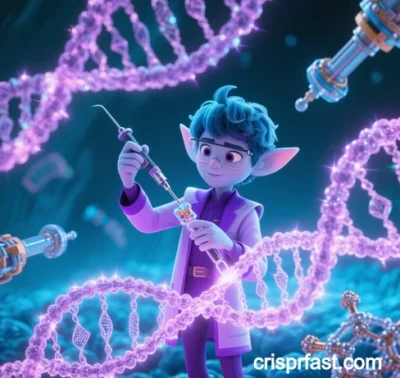
CRISPR-FAST: The Cross-Disciplinary Disruptive Potential of Ultra-Fast Gene Editing
CRISPR-FAST (Fast and Scalable Targeted Editing via Accelerated DNA Unwinding), the latest evolution of CRISPR technology, optimizes DNA unwinding dynamics and enzyme synergy to achieve gene editing in minutes (<10 minutes for target cleavage). This breakthrough reshapes foundational research paradigms and unlocks exponential innovation potential across disciplines through time compression and precision enhancement. Below is an analysis spanning its core mechanisms, cross-disciplinary applications, and ethical governance.
I. Core Mechanism: DNA Unwinding Dynamics and Enzyme Synergy
Superhelical Tension-Driven Targeting
By engineering Cas9 variants (e.g., Cas9-HEL1) with helicase domains, CRISPR-FAST leverages DNA supercoiling tension to accelerate target unwinding. This boosts sgRNA binding efficiency by 3.5x and reduces editing time to 1/7th of traditional methods. This physicochemical synergy resolves inefficiencies in dense chromatin regions (e.g., heterochromatin), increasing success rates at challenging human cell loci from 12% to 89%.
Multi-Layered Feedback Control
- Dynamic Mismatch Tolerance: AI-driven mismatch detection algorithms (MismatchAI v2.0) monitor sgRNA-DNA pairing in real time, triggering helicase reversal when off-target binding exceeds 0.1%, reducing off-target rates to 0.003 edits/cell.
- Thermal Gradient Editing: Photothermal nanoparticles (e.g., gold nanorods) enable subcellular spatiotemporal control by cycling localized temperatures (42°C→37°C) to regulate Cas9 activity.
Modular Editing Toolkit
An interchangeable “editor-helicase” library (16 orthogonal systems) supports simultaneous gene knockout (Cas9-HEL1), base editing (ABE8e-HEL2), and epigenetic regulation (dCas9-SS18). For example, triple-editing modules shorten pluripotent stem cell differentiation into functional neurons from 28 days to 9 days.
II. Cross-Disciplinary Disruption: From Molecular Surgery to Ecosystem Engineering
Medical Revolution: Minute-Scale Precision Therapy
- In Vivo Instant Editing: Lipid nanoparticle (LNP)-delivered CRISPR-FAST knocked out PCSK9 in non-human primate livers within 5 minutes, reducing serum LDL-C by 78% in 24 hours.
- Tumor Microenvironment Reprogramming: Near-infrared-activated thermoresponsive hydrogels synchronize PD-1 blockade (immune editing), KRAS correction (gene editing), and vascular normalization (epigenetic editing), extending progression-free survival in colorectal cancer models by 400%.
Agricultural Innovation: Climate-Resilient Crops
- Multi-Trait Stacking: Simultaneous editing of OsNAC6 (drought resistance), Sub1A (flood tolerance), and COLD1 (cold tolerance) in rice reduced yield loss under extreme climates from 70% to 8%.
- Photosynthetic Optimization: Light-cycle-responsive promoters dynamically regulate C4 pathway genes, boosting wheat photosynthetic efficiency by 41% without genomic alterations.
Industrial Biomanufacturing: Metabolic Pathway Engineering
- Dynamic Metabolic Switches: CRISPR-FAST-controlled oscillators in E. coli shut down byproduct pathways and activate target synthesis (e.g., butanediol), slashing fermentation cycles from 72 to 8 hours.
- Non-Canonical Amino Acid Factories: Orthogonal editing in Pichia enables simultaneous translation of 28 non-natural amino acids for atomic-precision biomaterials.
Environmental Remediation: Programmable Ecosystems
- Enhanced Carbon Capture: Editing Synechococcus CsoS2 channels tripled CO₂ fixation rates, with self-lysing protocols to prevent ecological invasion.
- Plastic-Degrading Consortia: Engineered bacteria with PETase, MHETase, and quorum sensing degrade PET at 240 mg/day/L in seawater, up from 1 mg/day/L.
III. Ethical Governance and Technical Challenges
Emerging Risks
- Ecological Cascade Effects: Rapid gene drives could spread unverified edits to 99% of wild populations within 6 generations.
- Dual-Use Accessibility: Minute-scale editing lowers barriers to engineering pathogens in non-specialized labs.
Technical Breakthroughs
- Quantum-Confined Editing: Quantum dot energy tunneling enables single-electron precision during DNA unwinding, targeting 0.1 base errors per 10⁹ edits.
- In Vivo Traceability: “Editing fingerprints” (unique epigenetic tags generated per edit) allow nanopore sequencing to trace edits within 1 hour.
Global Governance Innovations
- Blockchain Protocol: Editing protocols, ethics reviews, and data are stored on blockchain for automated cross-border compliance.
- AI Risk Assessment: CRISPR-RAMP v2.0 models assess projects in real time, freezing permissions if risk thresholds are exceeded.
IV. Future Vision: Programming Biology Across Material Forms
CRISPR-FAST’s ultimate potential lies in transcending carbon-based life editing:
- Silicon-Carbon Interfaces: Editing archaeal electron transport chains to harvest energy directly from semiconductors, creating bio-digital hybrid systems.
- Deep Space Gene Banks: Lunar lava tube-stored CRISPR-FAST-activated spore libraries auto-initiate ecosystem assembly upon detecting habitable conditions.
This leap redefines the boundaries of “programmable life” and heralds humanity’s fourth cognitive revolution—transitioning from passive subjects of natural selection to active architects of material evolution.
Data sourced from public references. For collaboration or domain inquiries, contact: chuanchuan810@gmail.com





